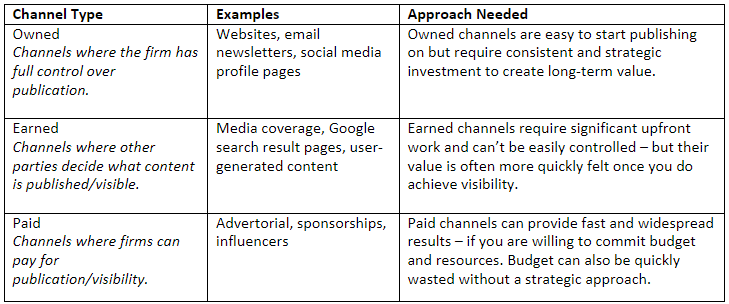Creating marketing content without a thoughtful, strategic distribution plan is like writing a book that never leaves the warehouse or a song that is never sung outside the garage. The content may be incredibly creative or insightful – but if no one reads or hears it, what does it matter?
Content only starts creating value when it ends up in the hands of its intended audience. In today’s content landscape, investment marketers must devote the same time and resources to their distribution plan as they do to their content strategy or writing the content itself.
The team at White Marble is passionate about partnering with investment marketers to successfully create and distribute content. Based on our experience, we believe the following are the core principles of a high-impact content distribution plan:
1. Go where the audience is – or invest the resources needed to make them come to you
The first step of developing a content distribution plan is to understand where your audience consumes content.
If you developed customer personas, these preferences should be a part of that larger picture. If not, you can learn channel preferences and develop those personas based on conversations with your internal stakeholders and your customers, and by reviewing pertinent data and best practices.
All content distribution channels can be divided into three core categories: owned, earned, and paid.

Each of these channel types has its benefits and drawbacks. Earned and paid channels require a longer timeline or a bigger budget, respectively – but if you can provide that, you can get your content in front of already engaged audiences.
Owned channels can publish content much more quickly and cheaply. To succeed, though, you must devote time and resources to incentivize an audience to pay attention to your channels.
Often, the most impactful content distribution plan for investment marketers will be a mix of all three channel types.
2. Leave a trail of breadcrumbs – of many different flavors
Content distribution plans can be fine-tuned for specific pieces or fully tailored for all content efforts. A firm will likely need a long-term, annual content distribution plan, in addition to narrower distribution plans for specific “hero” pieces, such as whitepapers, landing pages, or webinars.
For now, we’ll discuss a distribution plan for a specific piece of content. For these, you should strategically lead your audience back to your core piece by breaking up the messaging into compelling, insightful, and diverse promotions across their preferred consumption channels. Use calls-to-action to always give them a place to go next, building a compelling content journey for the reader.
Consider how PIMCO promoted their 2023 Secular Outlook, “The Aftershock Economy”:
- The core piece is a report hosted on their website.
- Based on the report, they hosted a webcast, also published on the video library of their website.
- They published snippets of the webcast to their YouTube account.
- They pulled quotes from the report for LinkedIn posts hyperlinking to the webpage.
- They collected video footage at an associated event to create a LinkedIn post driving to the report.
- PIMCO’s Chief Investment Officer appeared on Bloomberg The Open to discuss takeaways of the report.
- … and more.
This approach also underscores a key directive of content distribution – reuse and recycle. Rather than ideating new content for each of these channels, PIMCO adapted one report’s content, creating consistency in their messaging and efficiency in their processes.
3. Disrupt their scroll
Once marketers understand their audience’s channel preferences and have built a strategic content journey, they can’t then forget the final key ingredients to distributing content – creativity and quality.
Audiences are overwhelmed with content nowadays. To stand out on newsfeeds, in email inboxes, or wherever audiences are consuming content, firms must prioritize creative language and designs to capture eyes and authoritative, high-quality content to influence minds. Advances in AI – allowing content creators to conduct research, create images, and write copy more efficiently – will only continue to raise the minimum baseline of what’s considered “good” content. Firms need to continue pushing their boundaries or risk falling behind.
For example, consider how GQG Partners uses unique data visualizations and video snippets to share content on Instagram.

Through both eye-catching visuals and informative messaging, GQG stands a better chance of differentiating itself from other investment firms on its audience’s newsfeeds.
Overall, investment marketers should build content distribution plans that are targeted, connected, and creative. Creating content is hard work, so ensure your content can reach its full potential by giving distribution its proper due.
Explore the end-to-end content journey. Read our previous posts on creating a content strategy and writing engaging content.